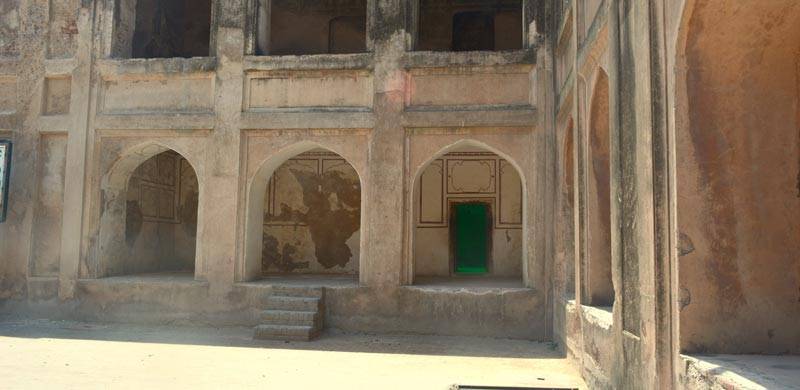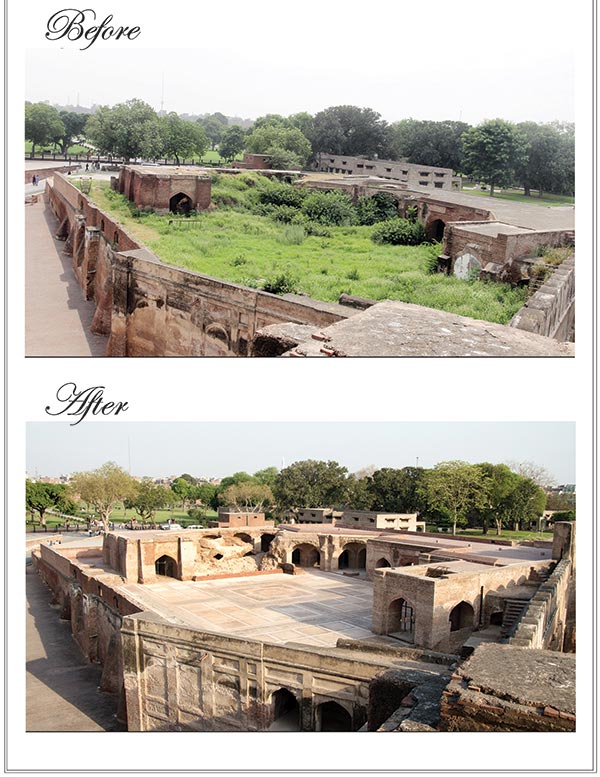
The Royal Kitchens inside Lahore fort is now much popular among people but it was a no go area till 2015. These Royal Kitchens are located at the backside of the Alamgiri Gate of Lahore Fort. A narrow passage will lead you to the place from the main entrance of Lahore Fort through the British era built road. Leading from a narrow passage you will come across a mesmerizing beauty of ages old structures now conserved. The walls built with small brick, the majestic arches attached together forming the kitchen area and roaming around in 400 years old arches you can imagine the past glory of the place with the hustle and bustle of the chefs and helpers while cooking food for the kings and queens.
The Royal Kitchens were constructed during the reign of Emperor Shah Jahan. It was where the food was prepared along with a huge variety of drinks, sweets and appetizers. The helpers would carry the food from there to the private chambers of the king, queen, princes, princesses and other courtiers.
When the Sikhs came to power and took over the Lahore Fort, the Royal Kitchens were damaged like many other buildings inside the Fort. The kitchen was converted into a food store room and at the same time it was used as a stable for horses and other animals.
The British in 1849 converted it into interrogation cells and jails. During that time the open verandas were closed with bricks and new structures like iron doors and beams were added along with the construction of an upper storey. The upper storey served as offices for policemen. The electricity supply lines, sewage system and water drains were laid during the British period. During the British Rule, another storey was added to the building.

What happened to this place after the partition? It is said that the Police Department used it as interrogation cells until late 1980’s, when they were handed over to the Archaeology Department. After partition, the building of Royal Kitchens was damaged more than ever. The beams, wooden doors and windows were taken away. Maybe those were pulled down during the riots. The building was extremely dilapidated and later some of the dilapidated parts were demolished and offices were constructed there. The building that we see today is the remaining part of the huge kitchen complex.
The walled city of Lahore Authority was handed over the administrative control of the Lahore Fort by the Government of Punjab in 2014 and thus in 2015, after revealing this deadliest and dangerous zone, where no one wanted to go, the planning for preserving the area started.
The on ground conservation of the Royal Kitchens started in 2015 by the Walled City of Lahore Authority and Aga Khan Trust for Culture. Photographic and technical documentation was carried out of the area which revealed the hidden elements of the place. The excavation of the place was the main task during which several other structures were also revealed and even walls having fresco work on them were exposed. All these structures had somehow gone underground with the passage of time. Similar to the conservation of Shahi Hammam and Wazir Khan Chowk, the original ground level of the place was revealed. Extensions and structures connecting to the temple of Loh were also found there with fresco work on them. Another interesting thing there was the 400 years old Tandoor. This was the most authentic evidence to the fact that this area was a kitchen during the Mughal days.
The Royal Kitchens are now preserved and form an integral part of the fort’s surroundings. The structure of the building has been given a new life. WCLA is holding regular cultural and Sufi events at the Royal Kitchens.
Prime Minister Imran Khan inaugurated the Royal Kitchens on 4th May 2019 and appreciated the conservation of the kitchens.
Behind the Royal Kitchens is an amazing structure very close to the stately Alamgiri Gate of Fort. This is the temple of Prince Loh.
The Mandir or Temple of Prince Loh, also known as Lava Mandir is located inside the Alamgiri Gate of Lahore Fort. Most of the historians and researchers claim this small room among other chambers that connect with the Alamgiri Gate of Lahore Fort to be the temple of Loh and some say that he was born there. It is a small dark room and open for the tourists. If you take a guide at Lahore Fort you will be able to see it and get to know the history in detail. Prince Loh has a deep connection with Lahore; this is what the historians claim. So when we talk about Lahore, we cannot ignore the mesmerizing love story of Rama and Sita and their children. It is said that Sita gave birth to twin sons, Lava and Kusha and a legend based on oral traditions holds that Lahore, known in ancient times as Lavapuri (City of Lava in Sanskrit), was founded by Prince Lava, the son of Sita and Rama, whereas the city of Kasur was founded by his twin brother Prince Kusha. This is the connection Loh has with Lahore.
The Royal Kitchens were constructed during the reign of Emperor Shah Jahan. It was where the food was prepared along with a huge variety of drinks, sweets and appetizers. The helpers would carry the food from there to the private chambers of the king, queen, princes, princesses and other courtiers.
When the Sikhs came to power and took over the Lahore Fort, the Royal Kitchens were damaged like many other buildings inside the Fort. The kitchen was converted into a food store room and at the same time it was used as a stable for horses and other animals.
The British in 1849 converted it into interrogation cells and jails. During that time the open verandas were closed with bricks and new structures like iron doors and beams were added along with the construction of an upper storey. The upper storey served as offices for policemen. The electricity supply lines, sewage system and water drains were laid during the British period. During the British Rule, another storey was added to the building.

What happened to this place after the partition? It is said that the Police Department used it as interrogation cells until late 1980’s, when they were handed over to the Archaeology Department. After partition, the building of Royal Kitchens was damaged more than ever. The beams, wooden doors and windows were taken away. Maybe those were pulled down during the riots. The building was extremely dilapidated and later some of the dilapidated parts were demolished and offices were constructed there. The building that we see today is the remaining part of the huge kitchen complex.
The walled city of Lahore Authority was handed over the administrative control of the Lahore Fort by the Government of Punjab in 2014 and thus in 2015, after revealing this deadliest and dangerous zone, where no one wanted to go, the planning for preserving the area started.
The on ground conservation of the Royal Kitchens started in 2015 by the Walled City of Lahore Authority and Aga Khan Trust for Culture. Photographic and technical documentation was carried out of the area which revealed the hidden elements of the place. The excavation of the place was the main task during which several other structures were also revealed and even walls having fresco work on them were exposed. All these structures had somehow gone underground with the passage of time. Similar to the conservation of Shahi Hammam and Wazir Khan Chowk, the original ground level of the place was revealed. Extensions and structures connecting to the temple of Loh were also found there with fresco work on them. Another interesting thing there was the 400 years old Tandoor. This was the most authentic evidence to the fact that this area was a kitchen during the Mughal days.
The Royal Kitchens are now preserved and form an integral part of the fort’s surroundings. The structure of the building has been given a new life. WCLA is holding regular cultural and Sufi events at the Royal Kitchens.
Prime Minister Imran Khan inaugurated the Royal Kitchens on 4th May 2019 and appreciated the conservation of the kitchens.
Behind the Royal Kitchens is an amazing structure very close to the stately Alamgiri Gate of Fort. This is the temple of Prince Loh.
The Mandir or Temple of Prince Loh, also known as Lava Mandir is located inside the Alamgiri Gate of Lahore Fort. Most of the historians and researchers claim this small room among other chambers that connect with the Alamgiri Gate of Lahore Fort to be the temple of Loh and some say that he was born there. It is a small dark room and open for the tourists. If you take a guide at Lahore Fort you will be able to see it and get to know the history in detail. Prince Loh has a deep connection with Lahore; this is what the historians claim. So when we talk about Lahore, we cannot ignore the mesmerizing love story of Rama and Sita and their children. It is said that Sita gave birth to twin sons, Lava and Kusha and a legend based on oral traditions holds that Lahore, known in ancient times as Lavapuri (City of Lava in Sanskrit), was founded by Prince Lava, the son of Sita and Rama, whereas the city of Kasur was founded by his twin brother Prince Kusha. This is the connection Loh has with Lahore.
